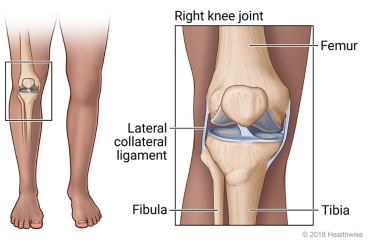Lateral Collateral Ligament (LCL) Injury: Care Instructions
Overview

The lateral collateral ligament (LCL) is a band of tissue on the outside of your knee. It connects your
thighbone (femur) to the bone of your lower leg (fibula). It helps keep the knee from bending outward. You can
sprain or tear this ligament during activities that involve bending, twisting, or a quick change of direction.
The ligament might be injured in sports such as football or soccer when the inside of the knee is hit.
Minor LCL injuries usually get better with treatment at home. Your doctor may suggest that you wear a brace.
It can help support your knee. You may need physical therapy for a moderate injury. A severe tear may need
surgery. Depending on how bad the injury is, healing could take weeks or months.
Follow-up care is a key part of your treatment and safety. Be sure to make and go to all
appointments, and call your doctor if you are having problems. It's also a good idea to know your test results
and keep a list of the medicines you take.
How can you care for yourself at home?
-
Put ice or a cold pack on your knee for 10 to 20 minutes at a time. Try to do this every 1 to 2 hours
(when you're awake) for the first 3 days after your injury or until the swelling goes down. Put a thin cloth
between the ice and your skin.
-
Prop up your leg on a pillow when you ice it or anytime you sit or lie down. Do this for about 3 days
after your injury. Try to keep your knee above the level of your heart. This will help reduce swelling.
-
Ask your doctor if you can take an over-the-counter pain medicine, such as acetaminophen (Tylenol),
ibuprofen (Advil, Motrin), or naproxen (Aleve). Be safe with medicines. Read and follow all instructions on
the label.
-
Do not take two or more pain medicines at the same time unless the doctor told you to. Many pain medicines
have acetaminophen, which is Tylenol. Too much acetaminophen (Tylenol) can be harmful.
-
Follow instructions about how much weight you can put on your leg and how to walk with crutches, if your
doctor recommends them.
-
Wear a brace, if your doctor recommends it, to protect and support your knee while it heals. Wear it as
directed.
-
Do stretches or strength exercises as your doctor suggests.
When should you call for help?
 Call 911
anytime you think you may need emergency care. For example, call if:
Call 911
anytime you think you may need emergency care. For example, call if:
Call your doctor now or seek immediate medical care if:
Watch closely for changes in your health, and be sure to contact your doctor if:
Current as of: July 17, 2023
Content Version: 14.0
Care instructions adapted under license by your
healthcare professional. If you have questions about a medical condition or this instruction, always ask
your healthcare professional. Healthwise, Incorporated disclaims any warranty or liability for your use of
this information.